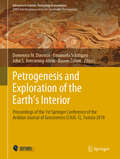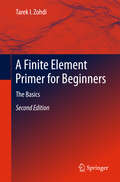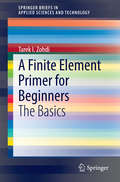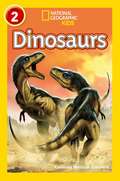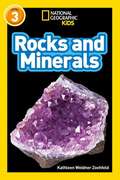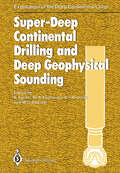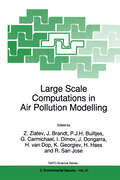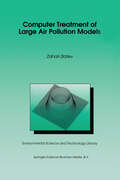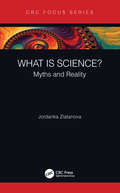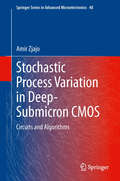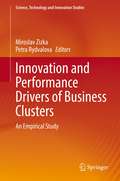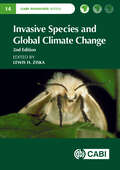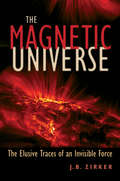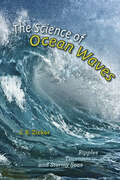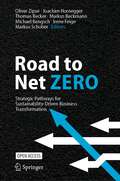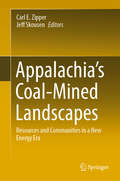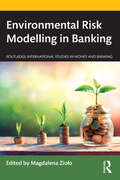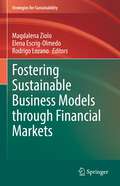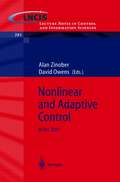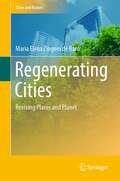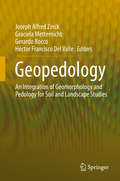- Table View
- List View
Petrogenesis and Exploration of the Earth’s Interior: Proceedings of the 1st Springer Conference of the Arabian Journal of Geosciences (CAJG-1), Tunisia 2018 (Advances in Science, Technology & Innovation)
by Basem Zoheir Domenico M. Doronzo Emanuela Schingaro John S. Armstrong-AltrinThis edited volume is based on the best papers accepted for presentation during the 1st Springer Conference of the Arabian Journal of Geosciences (CAJG-1), Tunisia 2018. The book is of interest to all researchers in the fields of Mineralogy, Geochemistry, Petrology and Volcanology.The Earth's interior is a source of heat, which makes our planet unique. This source regulates the formation and evolution of rocks at larger scales, and of minerals and sediments toward smaller scales. In such context, the exploration of georesources (products) has to be related to petrogenesis (processes).This volume offers an overview of the state-of-the-art petrogenesis and exploration in, but not limited to, the Middle East and Mediterranean regions. It gives new insights into processes and products related to the Earth's interior, and associated georesources by international researchers.Main topics include:1. Petrogenetic processes: geochemistry, geochronology and geophysical approaches 2. Surficial processes: sedimentation and facies analysis3. Applied mineralogy and tectonics4. Geological research applied to mineral deposits
A Finite Element Primer for Beginners: The Basics (SpringerBriefs in Applied Sciences and Technology)
by Tarek I. ZohdiThe purpose of this primer is to provide the basics of the Finite Element Method, primarily illustrated through a classical model problem, linearized elasticity. The topics covered are: • Weighted residual methods and Galerkin approximations,• A model problem for one-dimensional linear elastostatics,• Weak formulations in one dimension,• Minimum principles in one dimension,• Error estimation in one dimension,• Construction of Finite Element basis functions in one dimension,• Gaussian Quadrature,• Iterative solvers and element by element data structures,• A model problem for three-dimensional linear elastostatics,• Weak formulations in three dimensions,• Basic rules for element construction in three-dimensions,• Assembly of the system and solution schemes,• An introduction to time-dependent problems and• An introduction to rapid computation based on domain decomposition and basic parallel processing. The approach is to introduce the basic concepts first in one-dimension, then move on to three-dimensions. A relatively informal style is adopted. This primer is intended to be a “starting point”, which can be later augmented by the large array of rigorous, detailed, books in the area of Finite Element analysis. In addition to overall improvements to the first edition, this second edition also adds several carefully selected in-class exam problems from exams given over the last 15 years at UC Berkeley, as well as a large number of take-home computer projects. These problems and projects are designed to be aligned to the theory provided in the main text of this primer.
A Finite Element Primer for Beginners: The Basics (SpringerBriefs in Applied Sciences and Technology)
by Tarek I. ZohdiThe purpose of this primer is to provide the basics of the Finite Element Method, primarily illustrated through a classical model problem, linearized elasticity. The topics covered are:(1) Weighted residual methods and Galerkin approximations,(2) A model problem for one-dimensional linear elastostatics,(3) Weak formulations in one dimension,(4) Minimum principles in one dimension,(5) Error estimation in one dimension,(5) Construction of Finite Element basis functions in one dimension,(6) Gaussian Quadrature,(7) Iterative solvers and element by element data structures,(8) A model problem for three-dimensional linear elastostatics,(9) Weak formulations in three dimensions,(10) Basic rules for element construction in three-dimensions,(11) Assembly of the system and solution schemes,(12) Assembly of the system and solution schemes,(13) An introduction to time-dependent problems and(14) A brief introduction to rapid computation based on domain decomposition and basic parallel processing.
Dinosaurs: Level 2 (National Geographic Readers Ser.)
by Kathy Weidner Zoehfeld National Geographic KidsNational Geographic Primary Readers is a high-interest series of beginning reading books that have been developed in consultation with education experts. The books pair magnificent National Geographic photographs with lively text by skilled children’s book authors across four reading levels. In this Level 2 reader, youngsters learn all about the terrifying giants that once roamed the Earth – maybe even as close as their own backyard! They'll be wowed by new information and eye-popping illustrations from National Geographic, a trusted source of children's non-fiction content. Level 2: Becoming fluent: These books are a good match for kids who are developing reading stamina and enjoy a longer book. They are ideal for readers of Green, Orange and Turquoise books.
Rocks And Minerals: Level 3 (National Geographic Readers Ser.)
by Kathleen Weidner Zoehfeld National Geographic KidsNational Geographic Primary Readers is a high-interest series of beginning reading books that have been developed in consultation with education experts. The books pair magnificent National Geographic photographs with lively text by skilled children’s book authors across four reading levels. From dazzling gemstones to sparkling crystals to molten lava, this brilliantly illustrated book introduces children to the exciting world of rocks and minerals, including both the building blocks and the bling. This level 3 reader, written in easy-to-grasp text, will help cultivate the geologists of tomorrow! Level 3: Becoming independent: Best suited to kids who are ready for complex sentences and more challenging vocabulary, but still draw on occasional support from adults. They are ideal for readers of Purple and Gold books.
Super-Deep Continental Drilling and Deep Geophysical Sounding (Exploration of the Deep Continental Crust)
by Mark D. Zoback Anatoly IvanovitchKrivtsov Yevgeny A. Kozlovsky KarlFuchsThe articles in this volume were selected from a series of reports delivered in the So viet Union at Yaroslavl during the International Seminar "Super-deep drilling and deep geophysical research", which was organized and held in August 1988 by the Ministry of Geology of the USSR, jointly with the Inter-Union Commission on the Lithosphere. One of the most important problems of modem geology, is the state and prospects of further development of deep continental structure investigations, was discussed at the seminar with the participation of 245 scientists and specialists from 19 countries. At the plenary and sectional meetings of the seminar, 83 reports were delivered, discussions on the most interesting problems were organized, the exchange of ideas between the leading scientists a round table took place in discussion. The distinctive feature of the present collection of articles is the wide scope of the investigation of the Earth's crust. The reports elucidate such subjects of world impor tance as (1) achievements in implementation of major scientific programs investi gating deep Earth structure and plans for their further materialization; (2) theoretical problems of carrying out geological-geophysical explorations and drilling operations; and (3) new approaches to the study of the Earth's interior. The results of deep inves tigations of individual countries and organizations are considered, and concrete tech nical elaboration, methods of work execution, etc. are discussed.
Large Scale Computations in Air Pollution Modelling (NATO Science Partnership Subseries: 2 #57)
by Zahari Zlatev Jørgen Brandt Peter J. H. Builtjes Gregory Carmichael Ivan Dimov Jack Dongarra H. Van Dop Krassimir Georgiev Heinz Hass Roberto San José1. Contents of these proceedings. These proceedings contain most of the papers which were presented at the NATO ARW (Advanced Research Workshop) on "Large Scale Computations in Air Pollution Modelling". The workshop was held, from June 6 to June to, 1998, in Residence Bistritza, a beautiful site near Sofia, the capital of Bulgaria, and at the foot of the mountain Vitosha. 2. Participants in the NATO ARW. Scientists from 23 countries in Europe, North America and Asia attended the meeting and participated actively in the discussions. The total number of participants was 57. The main topic of the discussions was the role of the large mathematical models in resolving difficult problems connected with the protection of our environment. 3. Major topics discussed at the workshop. The protection of our environment is one of the most important problems facing modern society. The importance of this problem has steadily increased during the last two-three decades, and environment protection will become even more important in the next century. Reliable and robust control strategies for keeping the pollution caused by harmful chemical compounds under certain safe levels have to be developed and used in a routine way. Large mathematical models, in which all important physical and chemical processes are adequately described, can successfully be used to solve this task.
Computer Treatment of Large Air Pollution Models (Environmental Science and Technology Library #2)
by Zahari Zlatev"Models are often the only way of interpreting measurements to in vestigate long-range transport, and this is the reason for the emphasis on them in many research programs". B. E. A. Fisher: "A review of the processes and models of long-range transport of air pollutants", Atmospheric Environment, 17(1983), p. 1865. Mathematical models are (potentially, at least) powerful means in the efforts to study transboundary transport of air pollutants, source-receptor relationships and efficient ways of reducing the air pollution to acceptable levels. A mathematical model is a complicated matter, the development of which is based on the use of (i) various mechanisms describing mathematically the physical and chemical properties of the studied phenomena, (ii) different mathematical tools (first and foremost, partial differenti al equations), (iii) various numerical methods, (iv) computers (especially, high-speed computers), (v) statistical approaches, (vi) fast and efficient visualization and animation techniques, (vii) fast methods for manipulation with huge sets of data (input data, intermediate data and output data).
Coral Reefs of Cuba (Coral Reefs of the World #18)
by Vassil N. Zlatarski John K. Reed Shirley A. Pomponi Sandra Brooke Stephanie FarringtonThis comprehensive volume gathers foremost experts on the coral reefs of Cuba who represent a spectrum of disciplines, including biology, conservation ecology, economics and geology. The volume is organized along general themes including the Cuban Reef biota, reefs occurring in the Mesophotic and Eutrophic zones, ecology, conservation, management and the economic importance of the coral reefs of Cuba. The combination of case studies, new and previously published research, historical overview and examples of the ways in which research has contributed to the management and conservation of Cuban coastal resources provides a unique reference for graduate students and professionals holding a wide range of interests and expertise related to coral reef systems.
What is Science?: Myths and Reality
by Jordanka ZlatanovaIn a multitude of ways, science affects the life of almost every person on earth. From medicine and nutrition to communication and transportation, the products of scientific research have changed human life. These changes have mostly taken place in the last two centuries, so rapidly that the average person is unable to keep informed. A consequence of this "information gap" has been the increasing suspicion of science and scientists. The lack of true understanding of science, especially of "fundamental" research, motivates this effort to narrow this gap by explaining scientific endeavor and the data-driven worldviews of scientists. Key Features Fills an existing void in the understanding of science among the general population Is written in a nontechnical language to facilitate understanding Covers a wide range of science-related subjects: The value of "basic research" How scientists work by sharing results and ideas How science is funded by governments and private entities Addresses the possible dangers of research and how society deals with such risks Expresses the viewpoint of an author with extensive experience working in laboratories all over the world
What is Science?: Myths and Reality
by Jordanka ZlatanovaIn a multitude of ways, science affects the life of almost every person on earth. From medicine and nutrition to communication and transportation, the products of scientific research have changed human life. These changes have mostly taken place in the last two centuries, so rapidly that the average person is unable to keep informed. A consequence of this "information gap" has been the increasing suspicion of science and scientists. The lack of true understanding of science, especially of "fundamental" research, motivates this effort to narrow this gap by explaining scientific endeavor and the data-driven worldviews of scientists. Key Features Fills an existing void in the understanding of science among the general population Is written in a nontechnical language to facilitate understanding Covers a wide range of science-related subjects: The value of "basic research" How scientists work by sharing results and ideas How science is funded by governments and private entities Addresses the possible dangers of research and how society deals with such risks Expresses the viewpoint of an author with extensive experience working in laboratories all over the world
Stochastic Process Variation in Deep-Submicron CMOS: Circuits and Algorithms (Springer Series in Advanced Microelectronics #48)
by Amir ZjajoOne of the most notable features of nanometer scale CMOS technology is the increasing magnitude of variability of the key device parameters affecting performance of integrated circuits. The growth of variability can be attributed to multiple factors, including the difficulty of manufacturing control, the emergence of new systematic variation-generating mechanisms, and most importantly, the increase in atomic-scale randomness, where device operation must be described as a stochastic process. In addition to wide-sense stationary stochastic device variability and temperature variation, existence of non-stationary stochastic electrical noise associated with fundamental processes in integrated-circuit devices represents an elementary limit on the performance of electronic circuits.In an attempt to address these issues, Stochastic Process Variation in Deep-Submicron CMOS: Circuits and Algorithms offers unique combination of mathematical treatment of random process variation, electrical noise and temperature and necessary circuit realizations for on-chip monitoring and performance calibration. The associated problems are addressed at various abstraction levels, i.e. circuit level, architecture level and system level. It therefore provides a broad view on the various solutions that have to be used and their possible combination in very effective complementary techniques for both analog/mixed-signal and digital circuits. The feasibility of the described algorithms and built-in circuitry has been verified by measurements from the silicon prototypes fabricated in standard 90 nm and 65 nm CMOS technology.
Innovation and Performance Drivers of Business Clusters: An Empirical Study (Science, Technology and Innovation Studies)
by Miroslav Zizka Petra RydvalovaThis book highlights the importance of clusters for the competitiveness of companies and is divided into three interrelated parts. The first part focuses on localization economics, cluster theory, the role of innovation, and innovation partnerships in cluster formations. The second part of the volume presents original research carried out from 2018 to 2020 in the field of both natural clusters and organized clusters. In addition to examining the impact of cluster membership, the contributions also focus on additional factors that may affect the financial performance of companies. In the third part, an additional survey and case studies are presented, to examine the specifics of family businesses in selected industrial districts of the textile, glass, and jewelry industries. A broader overview of the development of dominant industries in the selected districts is provided, for an easier understanding of the relationships of competition among companies and locations in the business clusters. The book evaluates implications for microeconomic and macroeconomic policies and provides proposals for corporate inter-organizational behavior.This volume addresses scholars and researchers of economics, business, and management, as well as policy-makers and practitioners interested in a better understanding of innovation and performance drivers of business clusters.
Invasive Species and Global Climate Change (CABI Invasives Series)
by Lewis H. ZiskaThis book addresses topics related to the impact of invasive species including biosecurity, demographics, species diversity and food security. It is meant for researchers, upper-level students, and policy makers and provides a factual basis for the underlying science and a discussion of that information with respect to current and future impacts and possible solutions. This book explores the nexus of climate change and biological invasions, resulting impacts (biological and economic) and assesses ways to reduce vulnerability and increase the resiliency and sustainability of managed and unmanaged ecosystems. The book has three parts, focusing on: (1) the dimensions of the problem; background and science; (2) case studies; (3) Management: detection, prevention, control and adaptation. This revised edition examines a wide range of topics and region, the underlying science, examples (case studies) from around the world, and ways and means to recognize, manage and control the consequences. It includes new cases and new threats; for example, a chapter summarizing case studies regarding climate change and invasive species that are also disease carriers (e.g. ticks and Lyme disease). - Covers a wide range of topics and areas - Examines the synergy between invasive species and climate change - Explains options to control and mitigate effects This book is of interest to academics, researchers and students studying climate change and invasive species. Those interested in the environment and ecology, land managers, policy makers, agronomists, federal and state departments of natural resources, climate change activists, public health professionals.
The Magnetic Universe: The Elusive Traces of an Invisible Force
by J. B. ZirkerMagnetic fields permeate our vast universe, urging electrically charged particles on their courses, powering solar and stellar flares, and focusing the intense activity of pulsars and neutron stars.Magnetic fields are found in every corner of the cosmos. For decades, astrophysicists have identified them by their effects on visible light, radio waves, and x-rays. J. B. Zirker summarizes our deep knowledge of magnetism, pointing to what is yet unknown about its astrophysical applications. In clear, nonmathematical prose, Zirker follows the trail of magnetic exploration from the auroral belts of Earth to the farthest reaches of space. He guides readers on a fascinating journey of discovery to understand how magnetic forces are created and how they shape the universe. He provides the historical background needed to appreciate exciting new research by introducing readers to the great scientists who have studied magnetic fields. Students and amateur astronomers alike will appreciate the readable prose and comprehensive coverage of The Magnetic Universe.
The Science of Ocean Waves: Ripples, Tsunamis, and Stormy Seas
by J. B. Zirker"Powerful ocean waves fascinate the public, and they have made a lot of news lately." With that indisputable observation, scientist J. B. Zirker takes off on a whirlwind tour of the world of waves—from the "ordinary" waves that constantly churn the sea to the rogues or freaks that can rise up seemingly from nowhere to heights of 20 meters or more... and everything in between.Addressing questions most ocean visitors have had and offering new ones for our consideration, The Science of Ocean Waves explains in accessible language how waves are formed, how they move, how they become huge and destructive, and how they're being studied now for clues that will help us plan for the future.Devoting chapters to wind, tides, currents, breakers, tsunamis, forecasting, renewable energy, and El Niño—as well as discussing the gentler properties of ocean waves which inspire us and offer opportunities for relaxation and recreation—Zirker explores the physical factors that create waves.Drawing on some of the recent storms that have devastated entire regions—such as Hurricane Katrina, the tsunami launched by the 2004 Sumatran earthquake, and the great tsunami that crushed the shore of Japan in 2011—Zirker explains the forces that cause these monster waves and reveals the toll they take on human lives.Enhanced by dozens of illustrations and a comprehensive glossary, The Science of Ocean Waves will fascinate anyone curious about the science behind the headlines.Praise for J. B. Zirker"Scientists know their stuff but are rarely good storytellers, whereas good storytellers rarely possess the necessary sweeping command of a scientific discipline. Zirker is that rare animal who can both communicate the most demanding technical detail and make it accessible."—New Scientist
The Science of Ocean Waves: Ripples, Tsunamis, and Stormy Seas
by J. B. Zirker"Powerful ocean waves fascinate the public, and they have made a lot of news lately." With that indisputable observation, scientist J. B. Zirker takes off on a whirlwind tour of the world of waves—from the "ordinary" waves that constantly churn the sea to the rogues or freaks that can rise up seemingly from nowhere to heights of 20 meters or more... and everything in between.Addressing questions most ocean visitors have had and offering new ones for our consideration, The Science of Ocean Waves explains in accessible language how waves are formed, how they move, how they become huge and destructive, and how they're being studied now for clues that will help us plan for the future.Devoting chapters to wind, tides, currents, breakers, tsunamis, forecasting, renewable energy, and El Niño—as well as discussing the gentler properties of ocean waves which inspire us and offer opportunities for relaxation and recreation—Zirker explores the physical factors that create waves.Drawing on some of the recent storms that have devastated entire regions—such as Hurricane Katrina, the tsunami launched by the 2004 Sumatran earthquake, and the great tsunami that crushed the shore of Japan in 2011—Zirker explains the forces that cause these monster waves and reveals the toll they take on human lives.Enhanced by dozens of illustrations and a comprehensive glossary, The Science of Ocean Waves will fascinate anyone curious about the science behind the headlines.Praise for J. B. Zirker"Scientists know their stuff but are rarely good storytellers, whereas good storytellers rarely possess the necessary sweeping command of a scientific discipline. Zirker is that rare animal who can both communicate the most demanding technical detail and make it accessible."—New Scientist
Road to Net Zero: Strategic Pathways for Sustainability-Driven Business Transformation
by Oliver Zipse Joachim Hornegger Thomas Becker Markus Beckmann Michael Bengsch Irene Feige Markus SchoberWith this open access book, delve into the insights of respected leaders from academia and industry as they unravel the intricacies of sustainability-driven business transformation. This meticulously curated edited volume reflects on The Road To Net Zero, underscoring the need for pioneering pathways. Embark on a collaborative learning journey and explore key issues along the road to transformation, such as crafting corporate sustainability strategies, new forms of corporate disclosure, transforming value chains, and harnessing the power of technological innovation. Packed with guiding questions and distilled findings from research, this book is a must-read for all decision-makers, strategists, engaged citizens, educators, and learners committed to driving change and shaping a more sustainable future.
Appalachia's Coal-Mined Landscapes: Resources and Communities in a New Energy Era
by Carl E. Zipper Jeff SkousenThis book collects and summarizes current scientific knowledge concerning coal-mined landscapes of the Appalachian region in eastern United States. Containing contributions from authors across disciplines, the book addresses topics relevant to the region’s coal-mining history and its future; its human communities; and the soils, waters, plants, wildlife, and human-use potentials of Appalachia’s coal-mined landscapes.The book provides a comprehensive overview of coal mining’s legacy in Appalachia, USA. It book describes the resources of the Appalachian coalfield, its lands and waters, and its human communities – as they have been left in the aftermath of intensive mining, drawing upon peer-reviewed science and other regional data to provide clear and objective descriptions. By understanding the Appalachian experience, officials and planners in other resource extraction- affected world regions can gain knowledge and perspectives that will aid their own efforts to plan and manage for environmental quality and for human welfare.Appalachia's Coal-Mined Landscapes: Resources and Communities in a New Energy Era will be of use to natural resource managers and scientists within Appalachia and in other world regions experiencing widespread mining, researchers with interest in the region’s disturbance legacy, and economic and community planners concerned with Appalachia’s future.
Environmental Risk Modelling in Banking (Routledge International Studies in Money and Banking)
by Magdalena ZiołoEnvironmental risk directly affects the financial stability of banks since they bear the financial consequences of the loss of liquidity of the entities to which they lend and of the financial penalties imposed resulting from the failure to comply with regulations and for actions taken that are harmful to the natural environment. This book explores the impact of environmental risk on the banking sector and analyzes strategies to mitigate this risk with a special emphasis on the role of modelling. It argues that environmental risk modelling allows banks to estimate the patterns and consequences of environmental risk on their operations, and to take measures within the context of asset and liability management to minimize the likelihood of losses. An important role here is played by the environmental risk modelling methodology as well as the software and mathematical and econometric models used. It examines banks’ responses to macroprudential risk, particularly from the point of view of their adaptation strategies; the mechanisms of its spread; risk management and modelling; and sustainable business models. It introduces the basic concepts, definitions, and regulations concerning this type of risk, within the context of its influence on the banking industry. The book is primarily based on a quantitative and qualitative approach and proposes the delivery of a new methodology of environmental risk management and modelling in the banking sector. As such, it will appeal to researchers, scholars, and students of environmental economics, finance and banking, sociology, law, and political sciences.
Fostering Sustainable Business Models through Financial Markets (Strategies for Sustainability)
by Magdalena Ziolo Elena Escrig-Olmedo Rodrigo LozanoThe aim of this volume is to foster more sustainable business models through financial markets. To that end, it is necessary to know the main global challenges facing financial markets and their impact on creating sustainable value in business models of enterprises in the context of sustainable adaptation. The book focuses on assessing the decision criteria adopted by financial markets in the process of transaction risk valuation, in terms of the presence of Environmental, Social, and Governance (ESG) criteria, and by assessing the impact of including these criteria in the risk assessment process by financial markets in business decisions, leading as a consequence to building new value in the form of a sustainable business model. The book presents global ESG risks facing the financial markets, and discusses how ESG risks are managed and monitored, and how financial markets can measure and operationalize extra-financial risks in its assessment process. The book also analyses ESG risk implications and influences on company behavior, and the actions that companies should take considering the ESG assessment requirements of financial markets. Finally, it provides a comprehensive, structured, and systematic view of how financial markets and companies should adapt and improve their business models. The book provides unique challenges for investors, companies, financial markets, and for our society as a whole, advancing traditional risk management approaches to address global risks.
Nonlinear and Adaptive Control: NCN4 2001 (Lecture Notes in Control and Information Sciences #281)
by Alan S. I. Zinober David H. OwensDer Teichbau: Anleitung zur Anlage und zum Bau von Teichen für Kulturingenieure, Studierende und praktische Teichwirte
by F. A. ZinkDieser Buchtitel ist Teil des Digitalisierungsprojekts Springer Book Archives mit Publikationen, die seit den Anfängen des Verlags von 1842 erschienen sind. Der Verlag stellt mit diesem Archiv Quellen für die historische wie auch die disziplingeschichtliche Forschung zur Verfügung, die jeweils im historischen Kontext betrachtet werden müssen. Dieser Titel erschien in der Zeit vor 1945 und wird daher in seiner zeittypischen politisch-ideologischen Ausrichtung vom Verlag nicht beworben.
Regenerating Cities: Reviving Places and Planet (Cities and Nature)
by Maria Elena Zingoni de BaroThis book sets out the discussion on how cities can contribute solutions to some of the challenges the urbanised world is facing, such as the pressure of growing populations, mitigation of effects of, and adaptation to globally changing environmental, climate and public health conditions. Presenting a detailed explanation of the causes behind the current state of modern cities, the book advocates for a paradigm shift to improve the quality of life of ever-increasing urban inhabitants whilst nourishing the natural systems that sustain human and non-human life in the planet. Recognising the precious role that nature plays in the functioning of cities, it delves into the study of biophilic design and regenerative development. The book argues that these social-ecological design approaches can act as catalysts to develop conditions in urban settings that are beneficial for natural and human systems to thrive and flourish, both in ecosystem services and social-cultural systems. This is particularly relevant for the design of new quality precincts or the regeneration of degraded urban spaces to promote health, wellbeing and urban resilience. A framework is proposed to guide the process of thinking about, designing and building healthier, more liveable and resilient urban environments that raise the quality of life in cities. The method can be used by researchers, practitioners -urban designers, urban planners, architects and landscape architects- interested in developing their work within a social-ecological perspective. It can also be used by local governments and agencies to underpin policy making, and by educational institutions to prepare graduates with necessary skills to respond to current and future built environment challenges.
Geopedology: An Integration of Geomorphology and Pedology for Soil and Landscape Studies
by Joseph Alfred Zinck Graciela Metternicht Gerardo Bocco Héctor Francisco Del ValleThis book offers a proven approach for reliable mapping of soil-landscape relationships to derive information for policy, planning and management at scales ranging from local to regional. It presents the theoretical and conceptual framework of the geopedologic approach and a bulk of applied research showing its application and benefits for knowledge generation relevant to geohazard studies, land use conflict analysis, land use planning, land degradation assessment, and land suitability analysis.Soil is a vital resource for society at large and an important determinant of the economic status of nations. The intensification of natural disasters and the increased land use competition for food and energy have raised awareness of the relevant role the pedosphere plays in natural and anthropogenic environments. Recent papers and global initiatives show a renewed interest in soil research and its applications for improved planning and management of this fragile and finite resource.
